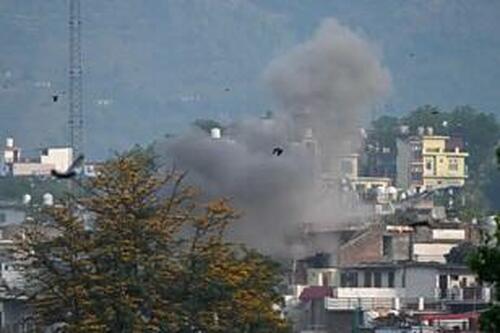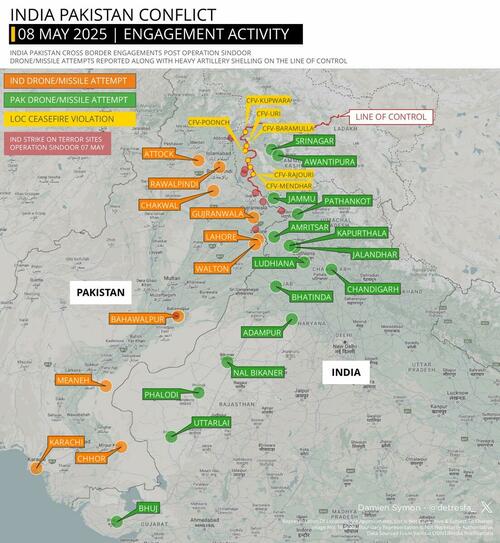In the latest developments along the war-ready Indian-Pakistan border, the Pakistani military says it has downed 25 Indian drones over its territory, while India in in turn is announcing it thwarted a Pakistani drone and missile attack on its military.
The official Pakistani death toll after the Wednesday missile ‘retaliatory’ attacks on Punjab province and Pakistan-administered Kashmir yesterday is at least 31 killed and dozens more wounded. Heavy artillery fire across the Line of Control (LOC) has remained steady, but the kind of feared wider and out of control all-out war has yet to be sparked. Islamabad is now claiming to have killed scores of Indian troops.

On the other side, the last 48 hours of hostilities has resulted in at least 13 people killed in Indian-administered Kashmir, with others wounded due to Pakistani fire.
India’s ‘Operation Sindor’ to avenge the 26 tourists killed last month’s terror attack has been called an ‘act of war’ by Pakistani leaders. Islamabad has denied any involvement in supporting or harboring the gunmen, amid repeat Indian accusations.
As for the newest major Indian drone attack, it mainly targeted the second-largest city of Lahore, and India’s government hailed that the operation successfully took out air defense radars at several locations. However, Pakistani Defense Minister Khawaja Asif rejected this, saying there was no damage, amid an ongoing fog of war where it’s hard for international observers to confirm much.
But as for a much bigger claim which has yet to be confirmed or substantiated, Al Jazeera reports that “Attaullah Tarar, the Pakistani information minister, has said the country’s armed forces have killed 40 to 50 Indian soldiers in the exchanges along the Line of Control dividing Indian- and Pakistan-administered Kashmir.” The assertions were made before legislators in the National Assembly.
Indian Foreign Secretary Vikram Misri’s latest words suggest New Delhi is still seeking to prevent escalation, claiming that all our air strikes were against “carefully selected terror targets” and that Indian drones and shelling have only hit sites connected to “incidents of cross-border terror in India and terrorist infrastructure.”
Drones shower in #Pakistan
India strikes back after Pak provokes at LoC
Pakistan targeted Indian military posts on May 7–8. 16 Indian civilians including 5 children killed in Pak shelling
India hit back, taking out Pak air defence radars near Lahore
India warns:… pic.twitter.com/MZpzbRJN0O
— Nabila Jamal (@nabilajamal_) May 8, 2025
And provocatively, he alleged that Pakistan has been “using religious sites as a cover to train terrorists” – which strongly suggests India’s assaults on Pakistan-administered Kashmir will continue, given the presence of armed Islamist factions. Much of this was directed at rejecting Pakistan’s claim that Indian air strikes have damaged the vital Neelam-Jhelum dam.
But the question of disinformation, and the motive for India’s ‘counterterror’ strikes, have been called “domestic theater” by one regional analyst:
Yet as tensions between the nuclear-armed neighbors escalate hour by hour, with Pakistan accusing India of launching a wave of drones into its territory on Thursday, military and geopolitical analysts question whether India’s approach serves as a deterrent against armed groups eager to target it. They argue that New Delhi’s actions are more symbolic and aimed at addressing its domestic audience rather than tactical advancement in the so-called “fight against terror”.
“This is all a domestic theatre,” said Ajai Sahni, executive director of South Asia Terrorism Portal (SATP), a platform that tracks and analyses armed attacks in South Asia. “The Indian strikes [in Pakistan] have no deterrent value.”
A steady spread of the border conflict…
Markets in India and Pakistan have again closed in the red, with India’s benchmark stock market indices – the Sensex and Nifty – having fallen around half a percent in trade.
Pakistan’s Karachi Stock Exchange was halted Thursday, with the benchmark KSE100 index losing more than 6% in trade. Amid the deep uncertainty the Indian rupee has slipped more than a percent against the US dollar.
Loading…


















